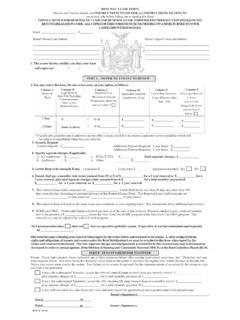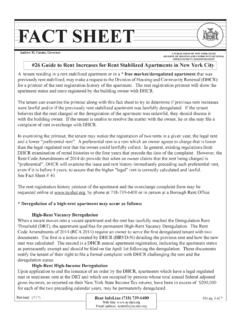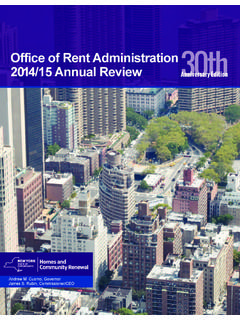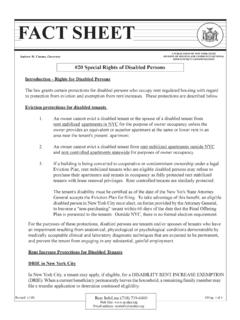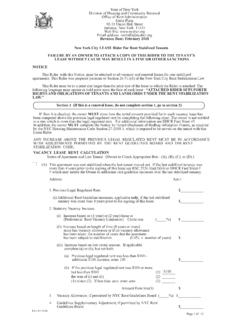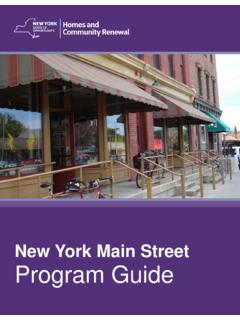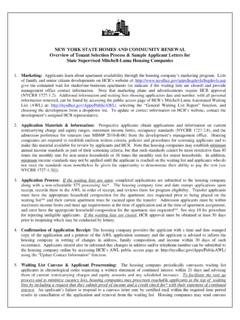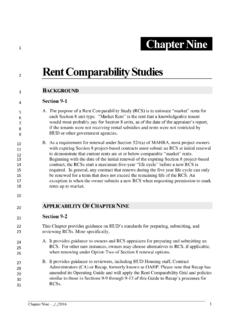Transcription of FACT SHEET - New York State Homes & …
1 fact SHEET Andrew M. Cuomo, Governor A PUBLICATION OF NEW york State . DIVISION OF HOUSING AND COMMUNITY RENEWAL. OFFICE OF RENT ADMINISTRATION. #5 Vacancy Leases in Rent Stabilized Apartments When a person rents a rent stabilized apartment for the first time, the owner and the tenant sign a VACANCY. LEASE. This written lease is a contract between the owner and the tenant which states the terms and conditions of the lease, including the length of the lease, and the rights and responsibilities of the tenant and the owner. The Rent Stabilization Law gives the new tenant (also called the vacancy lease tenant) the choice of a one- or two-year lease term. The rent the owner may charge for a vacancy lease cannot exceed the last legal regulated rent and the applicable vacancy increases authorized by law.
2 With the lease, a tenant should receive a Rent Stabilization Lease Rider/Addenda that states how the rent was computed and asserts that any increases comply with the Rent Stabilization Law and Code. Based on the Rent Code Amendments of 2014, vacancy lease rent increases cannot be collected if a DHCR. Order reducing rent for decreased services is in effect. (See Example - Vacancy Increase Barred) In addition, the Vacancy Lease Rider/Addenda completed by the owner must contain details about Individual Apartment Improvement (IAI) rent increase calculations. The Rider/Addenda must also contain a notice informing vacancy lease tenants of their right to request from the owner documentation that clarifies and supports the IAI increase, either at the time the lease is executed or within 60 days of its execution.
3 See DHCR. Operational Bulletin 2014-3 and DHCR fact SHEET # 2 for additional information regarding penalties for failure to provide the Rider/Addenda. Pursuant to the Rent Act of 2011, effective June 24, 2011, owners can charge and collect no more than one (1) vacancy lease rent increase in a calendar year (January 1st through December 31st). The following vacancy increases are added to one another, and are computed above the prior legal rent, to establish the legal regulated rent for the vacancy lease: 1. A 20 percent vacancy increase for a two-year vacancy lease; or a vacancy increase for a one-year vacancy lease equal to 20 percent minus the difference between the guidelines percentages applicable to two- and one-year renewal leases; or the Preferential Rent Vacancy Limitation.
4 The Rent Act of 2015 modified the vacancy allowance that an owner can add to the legal regulated rent when the vacating tenant was paying a preferential rent. If a vacating tenant was paying a preferential rent, the vacancy lease rent increase that can be applied to the vacating tenant's legal rent will be limited to 5% if the last vacancy lease commenced less than two years ago, 10% if less than three years ago, 15% if less than four years ago and 20% if four or more years ago. 2. If the owner did not collect a permanent vacancy increase within eight years of the new vacancy lease, in addition to the vacancy increase described in item 1, the owner is entitled to collect a vacancy increase equal to percent multiplied by the number of years since the collection of the last permanent increase.
5 3. If the previous legal rent was less than $ per month, in addition to the vacancy increases described in items 1 and 2, the owner is entitled to collect $ per month. 4. If the previous legal rent was between $ per month and $ per month, the owner is entitled to collect a vacancy increase equal to the greater of: a) the combined vacancy increases described in items 1 and 2; or b) $ per month. 5. The owner is entitled to add to the vacancy increases described in items 1, 2, 3 and 4 the vacancy increase authorized by the Rent Guidelines Board ("RGB"). Revised (11/15) Rent InfoLine (718) 739-6400 #5 pg. 1 of 3. Web Site: Email address: There are other situations in which different methods are used to establish vacancy lease rents.
6 1. If an apartment was vacant or temporarily exempt on the base date (4 years prior to the signing of the new lease) and for one or more years prior to that, the Owner may be entitled to the following rent increases: successive two year rent guideline increases for each additional two years that the apartment was vacant from the time the last rent stabilized tenant vacated until the signing of the subject lease, any other lawful increases such as Major Capital Improvements, the statutory vacancy increase, and any Individual Apartment Improvements that were made prior to the subject tenant taking occupancy. See (a)(3)(iii) and (a)(3)(iii). (See Example -- Vacant or Temporarily Exempt for more than 4 years.). 2.
7 If an apartment was vacant or temporarily exempt on the base date (4 years prior to the signing of the new lease) and for one or more years prior to that, and had no legal rent history previously established, the initial legal rent can be established by computing the average of the rent stabilized comparable apartments' rents in the building in effect on the date the initial rent stabilized tenant began occupancy and adding on the statutory vacancy adjustment and lawful individual apartment improvement rent increases. Apartments with the same number of rooms should be used when identifying comparable apartments. 3. If an apartment is a newly constructed unit or a new apartment because its previous outer dimensions were substantially altered, the owner may be entitled to set a first (negotiated) rent.
8 If the owner makes improvements to the apartment while the apartment is vacant, the owner is also entitled to collect a rent increase equal to either 1/40th or 1/60th of the cost of the improvement. This increase, known as an Individual Apartment Improvement Increase (IAI) is added to the rent, after the vacancy increases described above, are applied. Pursuant to the Rent Act of 2011, effective September 24, 2011, in buildings that contain more than 35 apartments, the owner can collect a permanent rent increase equal to 1/60th of the cost of the Individual Apartment Improvement (IAI). In buildings that contain 35 apartments or less, the owner can collect a permanent rent increase equal to 1/40th of the cost of the IAI, as had previously been allowed.
9 (See Example - IAI Calculation). Example - IAI Calculation Ms. Sanchez lives in a building with 50 apartments and vacates Apartment # 10 in September, 2011. She had lived in the apartment for ten years and when she vacated, her legal rent was $800. Ms. Lupino moves into the apartment and signs a two year vacancy lease that starts on October 1, 2011. The owner installed a new refrigerator that cost $600, including installation costs, when the apartment was vacant. Ms. Lupino's vacancy lease legal rent of $1,018, is calculated as follows: $800 - previous legal rent + $160 - 20% for a two year vacancy lease + $ 48 - 6% (.6% x 10 years since the last vacancy). + $10 - 1/60th of $600 for the new refrigerator $1,018.
10 Example - Vacancy Increase Barred Ms. Jones lives in a rent stabilized apartment and pays a legal rent of $1,000. She receives a DHCR rent reduction order for defective electric wiring and her rent is reduced by a guideline adjustment, making her collectible rent $975. She vacates the apartment a few months later on February15, 2014. Ms. Wilson moves in on March 1, 2014, pursuant to a 2 year vacancy lease and is charged a legal rent of $1,200. based on the statutory 20% vacancy increase. She visits a DHCR Borough Rent Office and learns that DHCR did not issue a Rent Restoration Order for the defective electric wiring and that the rent reduction order is still in effect. Ms. Wilson has the right to contact the owner and request that the owner reduce her collectible rent to $975 and that she be refunded any rent that she has paid in excess of that amount.
